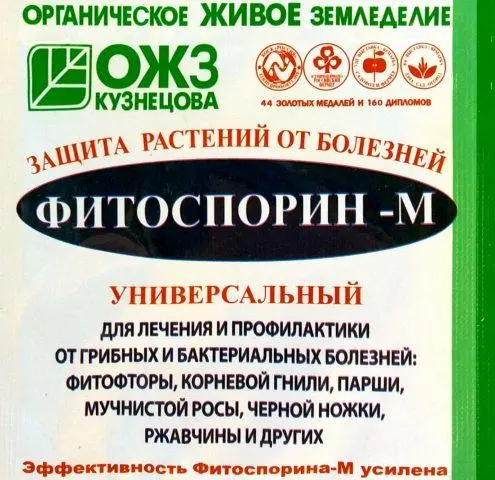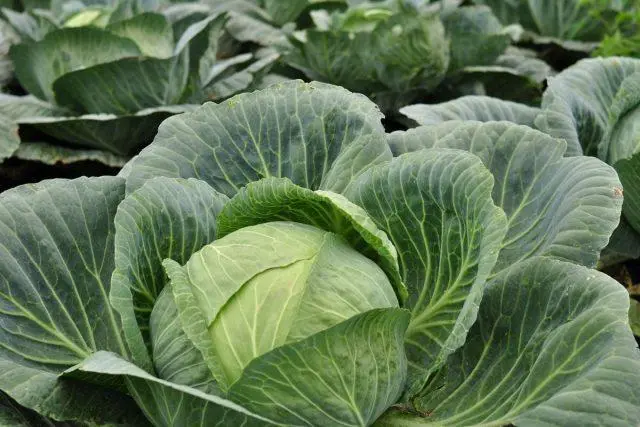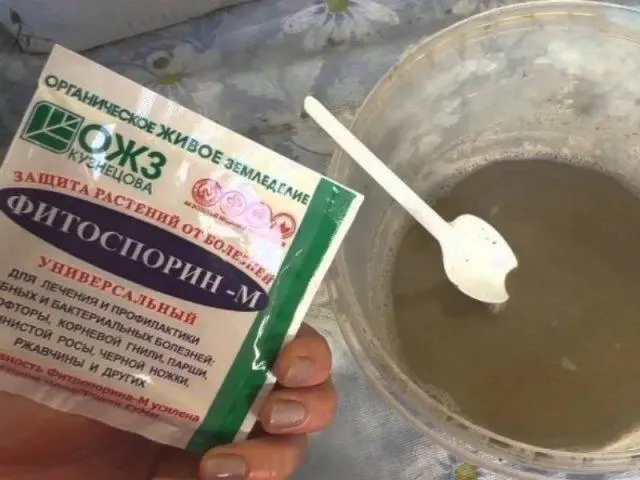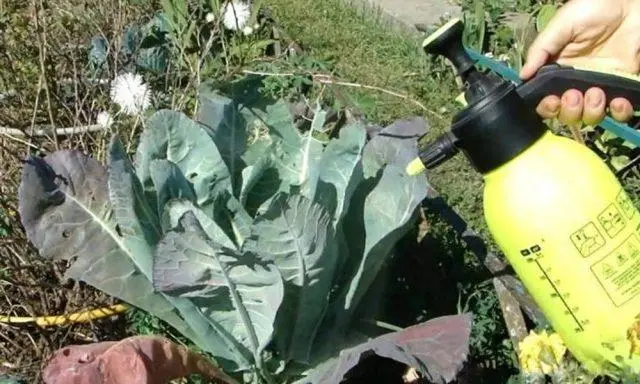Contents
The main condition for the successful cultivation of cabbage is to protect the vegetable from diseases. And most often in this case, gardeners resort to biological products. One of which is Fitosporin. The tool inhibits the development of pathogenic microflora, but does not contain aggressive toxic components, like chemical fungicides. Its use is especially important at the stage of formation and growth of heads, which guarantees the high quality of the harvested crop in the future. However, Fitosporin for cabbage must be used correctly, since only in this case it will be beneficial.

The drug belongs to the fourth hazard class
Composition and principle of action of the drug
On sale there are three forms of the drug: in the form of powder, paste, concentrate. However, the effectiveness of Fitosporin for cabbage does not depend on this. The product has a white or grayish-brown tint.
This drug belongs to the category of safe drugs. It consists of aerobic soil bacteria of the hay bacillus Bacillus subtilis, which suppress the viability of infections, fungi. But they are also antagonists of some microorganisms. And this means that with sufficient development of the colony, they displace other bacteria and thus protect the cabbage from diseases. The concentration of Bacillus subtilis in Fitosporin is 100 million live cells and spores per 1 g of the product.
Advantages and disadvantages
This drug has both strengths and weaknesses. And in order for its use to protect cabbage from diseases to be as effective as possible, it is necessary to study them in advance.

Fitosporin can be used at different stages of vegetable vegetation
The main advantages of the biological product:
- environmentally friendly;
- short waiting time before harvest;
- a wide range of actions;
- reduces the toxicity of agrochemicals;
- increases yield;
- accelerates the ripening of fruits;
- does not cause addiction in pathogens;
- increases the keeping quality of the crop;
- availability;
- ease of use.
Disadvantages:
- delayed action;
- sensitive to direct sunlight;
- partial resistance to rain washout.
How to use Phytosporin for cabbage
It is necessary to use the drug in the form of an aqueous solution, regardless of its form of release. But in order for it to be effective in processing cabbage, you need to properly prepare it. This should be done two hours before use to allow hay bacterium bacteria to become active. It is important that the temperature of the liquid used be in the range of + 35-45 ° C. Since the main active ingredient of Phytosporin are live microorganisms, hot or cold water can cause bacteria to hide in spores to wait out adverse conditions.
The drug can be used for:
- presowing treatment of vegetable seeds;
- immersion of the root system when landing in a permanent place;
- regular treatment of plants throughout the growing season;
- watering the soil at the stage of site preparation for its disinfection.
Fitosporin shows maximum effectiveness as a preventive measure, as well as in the treatment of fungal and bacterial diseases at an early stage of development. The protective effect of the drug appears three hours after the treatment of cabbage and lasts for 2-3 weeks.
Ways of processing
For the effective use of Fitosporin, it is necessary to strictly observe the dosage indicated on the package of the drug. When using the paste, you must first dilute it with water in a ratio of 1: 2.

Phytosporin is not compatible with drugs that have an acidic or alkaline environment
Features of the processing:
- Soaking seeds before sowing. It is recommended to dilute the powder at the rate of 0,5 tsp. per 100 ml of water, paste – two drops of concentrate per 100 ml of water, liquid agent – ten drops per 200 ml of water. The recommended duration of the procedure is two hours. At the end of it, cabbage seeds should be planted immediately.
- Soaking the root system before planting seedlings in a permanent place. In this case, it is necessary to dilute the powder at the rate of 10 g per 5 liters of water, the paste – concentrate four drops per 200 ml. It is necessary to soak the lower part of the cabbage seedlings in the Fitosporin working solution for 1-2 hours. Soaking can be replaced by watering already planted plants.
- For spraying cabbage on the leaf for prevention and treatment. Dilute the powder 60 g per 10 liters of water, paste – 3 tsp. concentrate for the same volume of liquid. Repeat treatment every 2-3 weeks.
If it is necessary to disinfect the soil before planting cabbage in the garden, it is recommended to dilute the powder 5 g or paste in the form of a concentrate 30 ml per 10 liters of water. Processing is recommended a week before transplantation.

The recommended consumption of the working solution when spraying the culture is 1 liter per 10 square meters. m
Safety measures
Despite the fact that this biological product is considered safe for human health, it is still necessary to follow certain precautions when using it. It is recommended to carry out processing with gloves. During the procedure, it is forbidden to drink, smoke, eat to prevent the drug from entering the human body. If this happens, then it is necessary to rinse the mouth, drink 3-4 glasses of water, induce vomiting and take activated charcoal at the rate of a tablet for every 10 kg of body weight.
Conclusion
Phytosporin for cabbage, as well as other garden crops, is considered the safest fungicide that allows you to grow an environmentally friendly crop. But the effectiveness of the use of this drug directly depends on compliance with the rules for its use. Therefore, it is recommended to strictly adhere to the indicated dosage, and also take into account that the remedy must be prepared in advance. Only in this case, the bacteria of hay bacillus, which are part of it, are able to suppress the activity of fungi.









